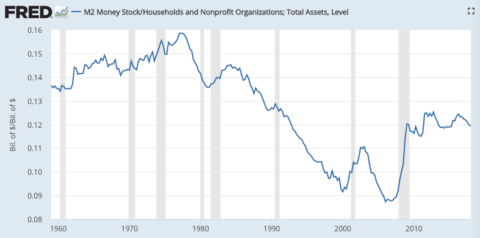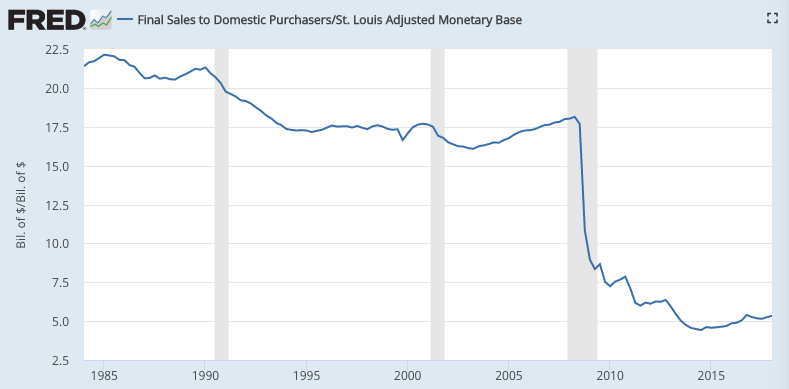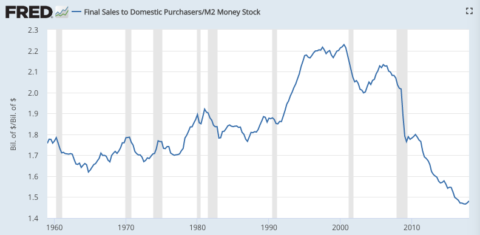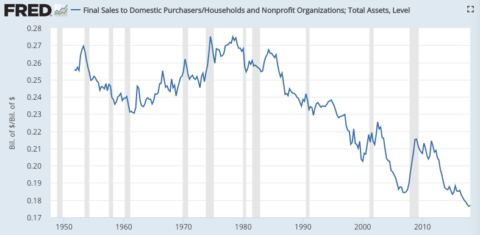By Steve Roth
Money makes the world go round. That may well be true, but money certainly makes the economics world go round. It’s the discipline’s special purview, the numeric linchpin that gives economics its dominant role and voice in our affairs. It’s what makes economics seem so “objective” compared to other social sciences.
Given that, it’s remarkable that economists don’t have an agreed-upon definition of the word. Sure, there’s the three- or sometimes four-part “money serves as…” non-definition that you learn in Econ 101. But in practice, what you see is a hodge-podge of unstated and shifting meanings in economic discussions.
The problem is, there are multiple, perfectly valid, widely-used meanings for the word. They’re all “correct.” The challenge is to be clear on each of those meanings, and on which ones are being used in a discussion.
Here’s a shot at defining those commonly-used meanings, and the relationships between them. Note that this is dictionary-style: describing the meanings people use, not prescribing what money “should” mean.
money. n.
1. A technology invented ca. fourth-millenium BCE for tallying up the value of diverse ownership claims, and designating prices, numerated in arbitrary units of account. “What’s the summed-up numeric value of two goats plus three chickens?”
2. Wealth: the sum of tallied balance-sheet assets (see #1). Ask a real-estate tycoon or mutual-fund investor, “How much money do you have?”
3. Financial instruments whose market prices are institutionally pegged to a unit of account. Fixed-price instruments: physical cash, checking and money-market balances, etc. (The price of a dollar bill or a one-dollar checking-account balance is always one dollar.) A subset of #2. “How much ‘cash’ do you have in your portfolio, on your balance sheet — assets/instruments whose prices never change?”
This satisfies another commonly used definition of money: “stuff you can use to buy stuff.” People accept (actually require) these fixed-price assets in trades, for both real goods and financial instruments, because they have a fixed price. Sellers know exactly what they’re getting — at least relative to the unit of account.
This is also the unstated definition of the instruments that are tallied up in monetary aggregates: fixed-price instruments.
4. Coins and currency. Physical tokens representing (fixed-price) balance-sheet assets, which make it easy to transfer those assets from one balance sheet to another. A subset of #3. “How much money do you have in your pocket?”
In practice, in our liquid financial system, you can easily swap some of your Apple shares for “cash” (#3 money), and swap the cash for a car, or for treasury bonds.
“Do you have enough money to buy that car?” is obviously not asking about the proportion of #3 money in your portfolio. It’s about #2 money: do you have enough assets to buy that car? Someone with a big stock portfolio has a lot more money (actually, effectively), so can buy a lot more cars.
As long as the financial system is working smoothly, #2 money is a perfectly sensible meaning for the word. That’s why people use that meaning of the word, all the time.
The third definition also deserves scrutiny. Is this how people or economists talk about money? Yes. Go through the monetarist-dominated literature, and you’ll see: It’s the unstated definition of what we might call “monetarists’ money.” It’s what they mean when they use the word.
Are these definitions useful? Do they make it easier to discuss and clearly understand economic issues, to talk and think together about money?
Let’s start with the “where money came from” conversation. What kind of money is it asking about? Coins weren’t invented until circa 8th century BCE. But tally sheets using arbitrary units of account, #2 money, go back thousands and maybe tens of thousands of years. Writings referring explicitly to monetary units of account — long-divorced from their possible linguistic roots as physical commodity measures — are extremely widespread, and also go back millennia.
Whatever the merits of these four definitions, they at least let us be clear when we ask what kind of “money” invention we’re talking about.
Next: what do economists today mean by the “money supply”? Let’s assume they’re talking about a “money stock,” not a flow measure as implied by the confusing (confused?) use of the word “supply.” They’ll point you to monetary aggregates (M0, M2, MZM, MB or monetary base, etc.), which are all tallies of #3 money, fixed-price instruments. Different aggregates tally up different sets of instruments, but the general sense is clear: the money “supply” equals the outstanding stock of fixed-price instruments.
But these fixed-price instruments are a pretty small subset of the larger definition, #2 money, “how much money do you have?” Only ten to fifteen percent of U. S. households’ wealth/assets, for instance, consist of fixed-price instruments. Variable-priced instruments (bonds, equity shares, land titles, etc.) dominate this larger pool of money. That seems like a useful hard-line distinction when thinking about money and how it works.
Next, “demand for money.” What does this mean? It always refers to demand for #3 money, fixed-price instruments. So it’s talking about portfolio preferences — how much of their portfolios do wealthholders want to hold in “cash”? You can get a sense of this here:

(Note that household total assets includes the market value of all firms, because households ultimately own all equity shares, at zero or more removes. Firms don’t own households — not since the Civil War. Households don’t issue equity shares. So household assets/wealth is a good “telescoped” measure of total private-sector assets/wealth, the #2 money stock.)
This “demand for money” in today’s economy is not about main-streeters needing more “cash” so they can spend and buy stuff, so driving up the “price of money” (an oxymoron, since these #3 money instruments have fixed prices; it’s their sine qua non). It’s easy to swap enough assets for cash, when necessary for purchases. It’s about the wealthholders wanting to hold a higher proportion their assets in #3 “cash.”
Next, how about “velocity of money”? For monetarists, this means the velocity of #3 money, as measured in various monetary aggregates. How much do those money stocks turn over in spending each year? Do those velocity ratios yield useful economic insights — especially about people’s propensity to spend?
Let’s look at that for two #3 money aggregates. Here’s MB or Monetary Base (physical cash/coins plus banks’ “reserve” holdings at the Fed):

This is wildly skewed after 2008, obviously, by QE: the Fed bought a bunch of (variable-priced) bonds from the private sector, swapping Fed fixed-price reserves in return. So MB went way up. This velocity measure/ratio is dominated by that “artificial” change in the denominator, which makes it hard to deduce anything useful about changes in the numerator — spending.
How about M2 — a broad measure of currency in circulation plus checking, saving, and money-market account holdings? (It doesn’t include Fed reserve balances, or — much less significant — banks’ physical “vault cash.”)

This velocity seems to decline before/during/after recessions, so there may be some cyclical insight here. But the pattern and its probable causes are hard to discern — long-term patterns/effects even more so. (Suggestions welcome.)
It’s not at all clear that the stock of fixed-priced instruments as the denominator of a velocity ratio is terribly revealing.
But what if we use #2 money, assets/wealth, as our measure of money hence velocity?

There’s a clear and quite massive trend here from the late 1970s/1980 to today, and it’s strikingly familiar. (Think: Inflation rate, interest rates, wage growth, labor share.) Does it tell us anything about spending (propensities) or other economic effects?
I’ll leave that question with my gentle readers. But whatever the economic takeaways from these measures and ratios, in each case we can clearly understand what we mean when we say “money.” Perhaps these careful definitions will be useful in clarifying economic discussions.
2018 August 4
Donating = Changing Economics. And Changing the World.
Evonomics is free, it’s a labor of love, and it's an expense. We spend hundreds of hours and lots of dollars each month creating, curating, and promoting content that drives the next evolution of economics. If you're like us — if you think there’s a key leverage point here for making the world a better place — please consider donating. We’ll use your donation to deliver even more game-changing content, and to spread the word about that content to influential thinkers far and wide.
MONTHLY DONATION
$3 / month
$7 / month
$10 / month
$25 / month
You can also become a one-time patron with a single donation in any amount.
If you liked this article, you'll also like these other Evonomics articles...
BE INVOLVED
We welcome you to take part in the next evolution of economics. Sign up now to be kept in the loop!
























